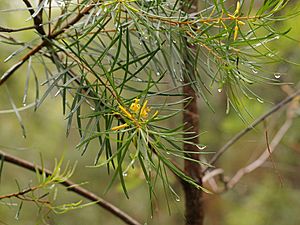Persoonia virgata facts for kids
Quick facts for kids Persoonia virgata |
|
|---|---|
 |
|
| Scientific classification | |
| Genus: |
Persoonia
|
| Species: |
virgata
|
| Synonyms | |
|
|
The Persoonia virgata is a special kind of flowering plant. It belongs to a plant family called Proteaceae. You can only find this plant growing naturally in the coastal areas of eastern Australia. This means it is endemic to that region. It usually grows as an upright bush with smooth bark. Its young branches are a bit hairy. The leaves are long and thin, or shaped like a small spoon. This plant has pretty yellow flowers. These flowers grow in groups of up to seventy-five on a long stem called a rachis. This stem can be up to 230 millimeters (about 9 inches) long. What's cool is that this stem keeps growing even after the flowers bloom!
What Does Persoonia virgata Look Like?
Persoonia virgata is usually an upright bush, also known as an erect shrub. Sometimes, but rarely, it can grow flat along the ground. This is called a prostrate shrub. It typically grows to be between 0.5 and 4 meters (about 1.5 to 13 feet) tall. It has smooth bark. When the branches are young, they are covered with whitish or grayish hairs.
The leaves of this plant are quite unique. They are either long and thin, which we call linear. Or they can be shaped like a narrow spatula or spoon. These leaves are usually 20 to 50 millimeters (about 0.8 to 2 inches) long. They are also very thin, only 1 to 2 millimeters (about 0.04 to 0.08 inches) wide.
The flowers are arranged in groups. You can find up to seventy-five flowers on a single stem called a rachis. This stem can grow up to 230 millimeters (about 9 inches) long. What's interesting is that this rachis keeps growing even after the flowers have bloomed. Each flower sits on its own small stalk called a pedicel. These pedicels are 4 to 9 millimeters (about 0.16 to 0.35 inches) long. At the bottom of each pedicel, there's a small leaf. The flower parts that look like petals are called tepals. They are yellow and are also 4 to 9 millimeters long. These tepals are glabrous, which means they are smooth and hairless. You can usually see Persoonia virgata flowering from December to March.
How Was Persoonia virgata Named?
The scientific name for Persoonia virgata was first officially given in 1810. A famous botanist named Robert Brown described it. He wrote about it in a scientific publication called the Transactions of the Linnean Society of London. He studied plant samples he had collected near a place called Sandy Cape.
Where Does Persoonia virgata Live?
This special plant, also known as a geebung, grows in specific types of environments. It can be found in areas ranging from open heathlands to forests. It mostly grows on old sand dunes near the coast. You can find Persoonia virgata in eastern Australia. Its range stretches from Shoalwater Bay in Queensland down to Forster in New South Wales.

